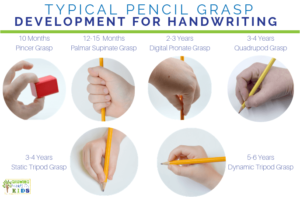 Do you have a good sense of your child’s hand preference?
Do you have a good sense of your child’s hand preference?
I am a pediatric occupational therapist, and this is a common conversation that I have with parents. While hand dominance is hereditary, its not a given. Science tells us that hand dominance is only about 24% heritable. Both my husband and I are right-handed, and my oldest is a leftie. Depending on their age, I work with children on specific motor skills, including their hand/eye/foot preference as a precursor to higher level fine motor skills and gross motor skills. How can you know if you child is on track?
Many parents notice a hand preference as early as age 2.
You may see consistency in the hand they use to color and cut (when they’re ready), but there are other ways to detect preference. Watch what hand is used to hold a toothbrush or fork/spoon. Offer art supplies at midline (center) and see how often they grasp with either hand. See what side of the body is preferred when throwing or kicking a ball.
Its still OK for kids to switch hands between 4 and 6
Many of my clients go back and forth between left and right when coloring. Its important to make sure that they are crossing midline – as this is a developmental precursor to higher level motor tasks. This means that they reach across their body with one hand to grab a utensil, instead of picking up with one hand, and transferring it at midline to the other. My advice to parents when kids switch hands – encourage the finish. Finish using the red marker with the left hand, before coloring blue with the right. Snip across the paper with scissors in the right hand, before switching quickly to the left because of fatigue.
Remember: true dominance isn’t established until 7.
This is a neurological marker, when the brain/body connection is strong and in sync. Preference is likely seen much earlier, but true DOMINANCE can be as late as age 7.
Rest assured, hand dominance will become clear.
Most of the time, you will have a good idea of hand skills by the time kindergarten rolls around. Once school begins, teachers and school-based occupational therapists are screening for fine motor delays that impact students at school. Kids will have to get on their seasonal clothes, manage their backpacks and open lunch containers under the watchful eyes of their teacher. Much of their work in kindergarten involves cut/color/paste, so trust that they are getting fine motor practice on the daily. If you have concerns, bring them up at parent-teacher conferences (and try my favorite tool for fine motor skills).
Some red flags to watch for:
1). Crossing Midline
When scribbling on paper, you can notice lines that cross the center of the paper, instead of the right hand coloring on the right side of the paper, while the left colors on the left side.
2). Poor bilateral skills
Tasks like catching a ball, holding paper while cutting, jump-roping, shoe-tying and even bike-riding requires both sides of the body.
3). Maladaptive grasp patterns
The following age norms are a guideline, look for a developmental progression. Modify fine motor work by utilizing a vertical surface when possible. Encouraging wrist extension while working upright facilitates grasp. Incorporate black/white boards, tape paper onto a wall/easel, use a slant-board.

4). Avoidance of fine motor tasks
Even with adequate exposure to fine motor tasks, art projects and sensory mediums, some kiddos still avoid the crayons and scissors like the plague. That’s OK, it will get better – don’t force something if it becomes negative. Think outside the box though – even Lego and other building toys hone the fine motor skills. Scratch art can be engaging, tearing/cutting card-stock mailers, Lite Brite or other peg-type play are all fine motor. Play-doh tools, clay creations and Wikki Sticks are also some of my favorite non-paper/pencil activities.
Still, if you’re concerned about your child’s development, talk to your pediatrician about the potential need for occupational therapy.










